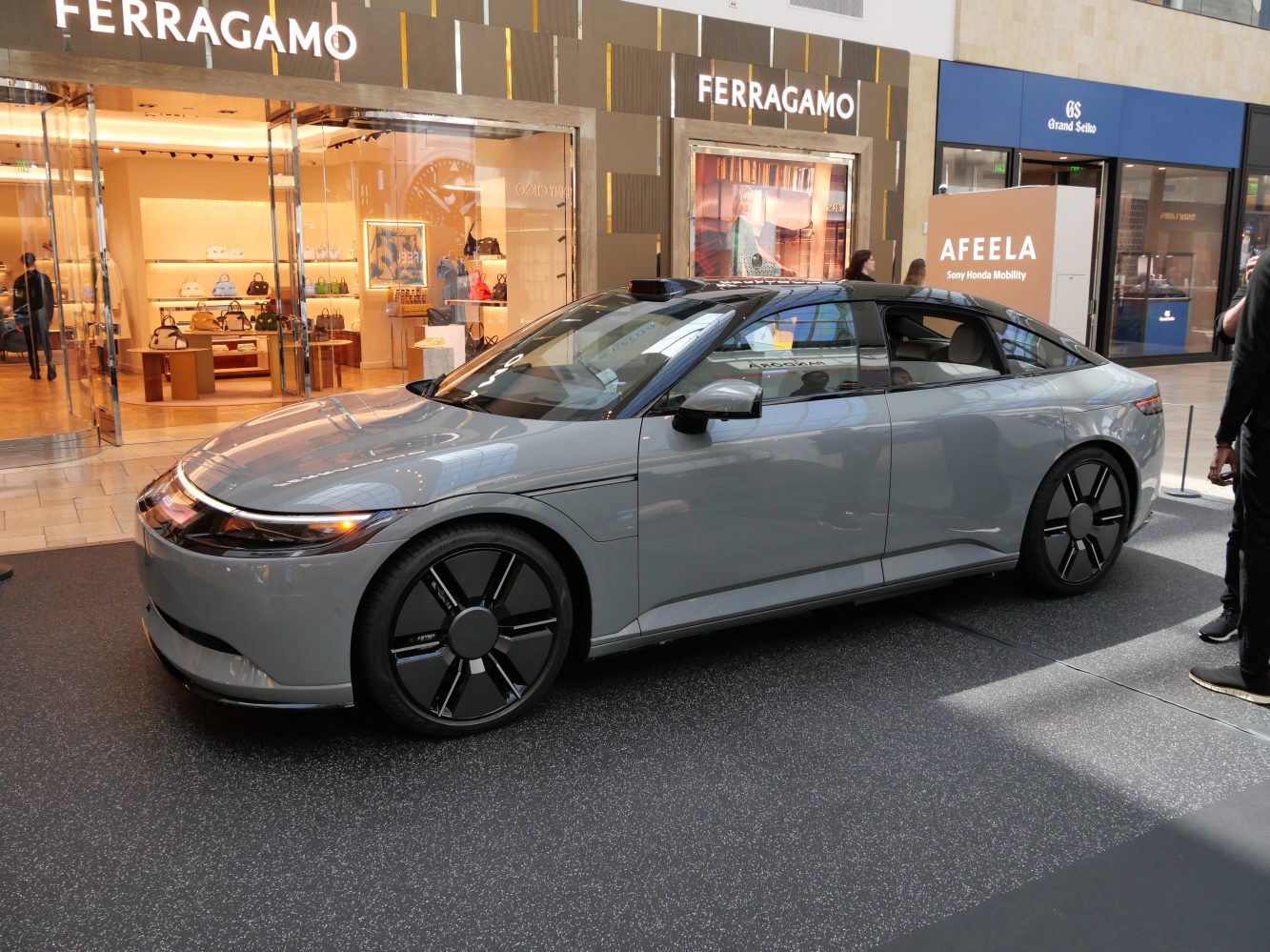
Sony Honda Mobility is touring around with its AFEELA prototype, and we got a chance to have a look at it up close in LA.
AFEELA is the official name of Sony’s fledgling electric car brand, which Sony first showed off as the “VISION-S” at CES in 2020, and has evolved bit by bit every year since then, now with an eventual release date of 2026. Since then, it has formed a joint venture with Honda, called Sony Honda Mobility (SHM), to bring the car to market.
The AFEELA booth was set up in Westfield Topanga, north of LA, where the car will be on display until April 1. We got a chance to have a sit in it and get a technology demo of some of the interior and UI features, though it was still quite limited and in prototype form.
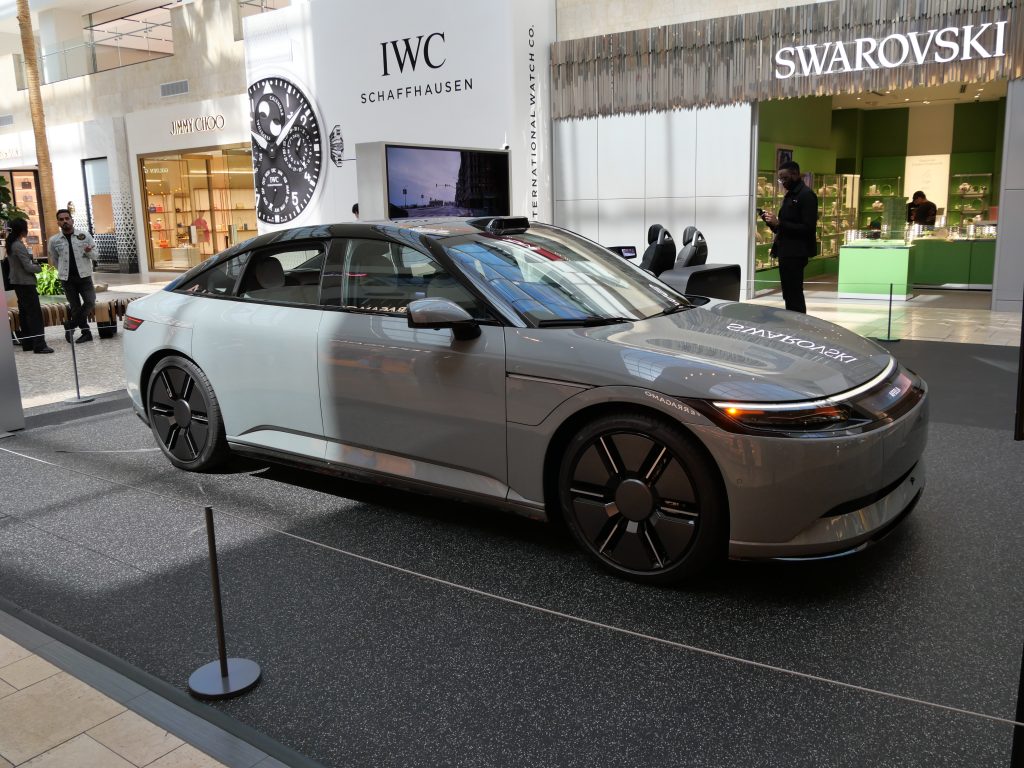

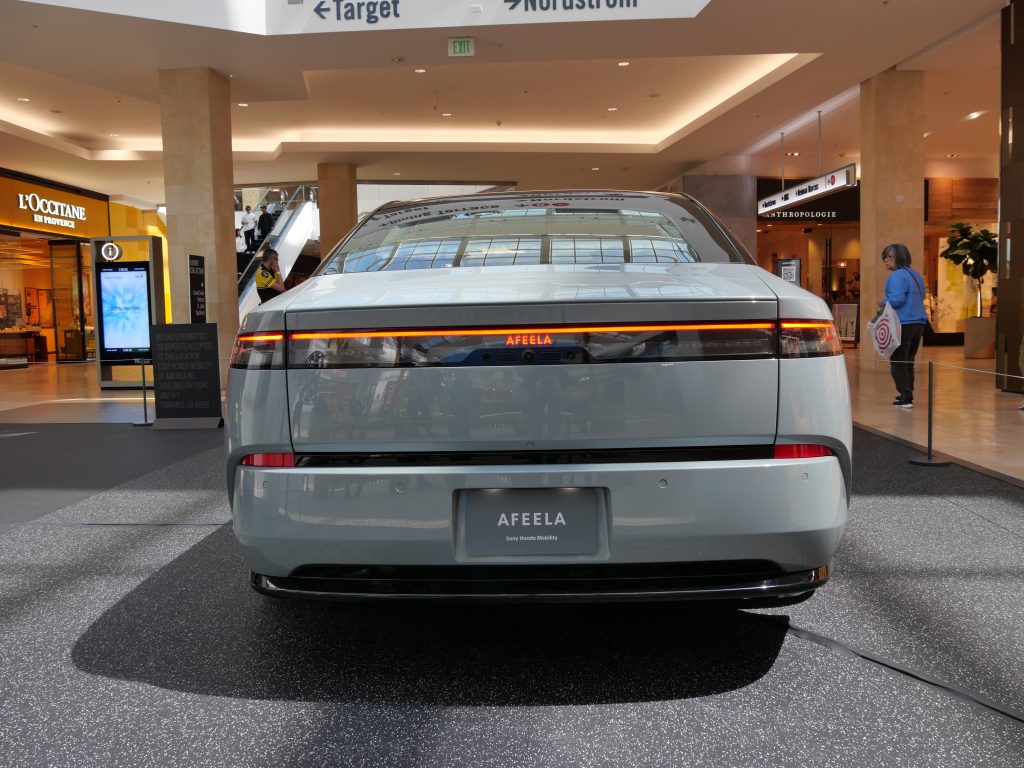
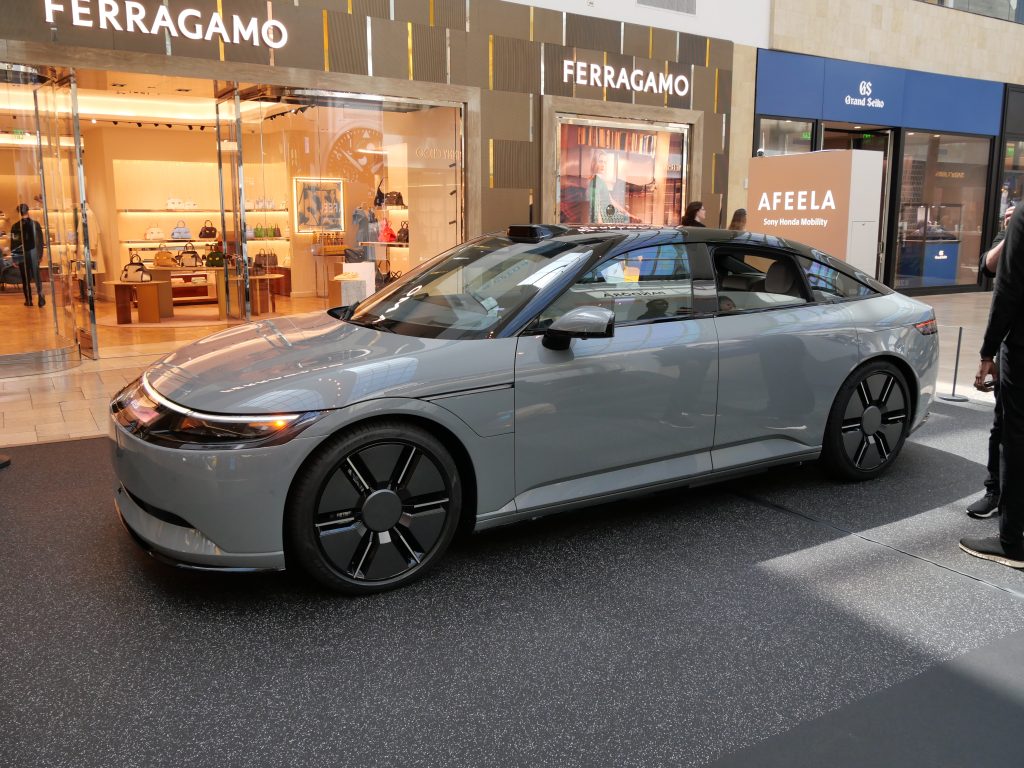
To recap, Sony’s concept was originally stated to have 400kW (536hp) dual-motor all-wheel-drive, 0-100km/h (0-62mph) in 4.8 seconds, and a top speed of 240km/h (149mph). That said, we don’t know if those are still the specs they’re aiming for. And we still have no information on price or battery size (though they have said they want to offer ten-year leases), but we do have two more years until this project bears fruit after all.
And things could change a lot before then. While the original VISION-S concept was pitched with the specs above, we haven’t heard them mentioned since. Sony did show off the car doing road testing in Europe in 2021, but ever since the joint venture with Honda, Sony’s demonstrations have been characterized more as tech demos of potential in-car experiences for a software-defined vehicle.
So… this was sort of a car demo, but more of a technology demo (as they reminded us many times). Despite being only 2 years away, anything that we saw could and probably will change, so keep all of that in mind.
As I and another journalist arrived for a tour, our tour guide stepped aside for a moment and then brought us around to the front of the car, where we saw the first of the AFEELA’s neat features: a customizable front “media bar” which greeted us for our tour.
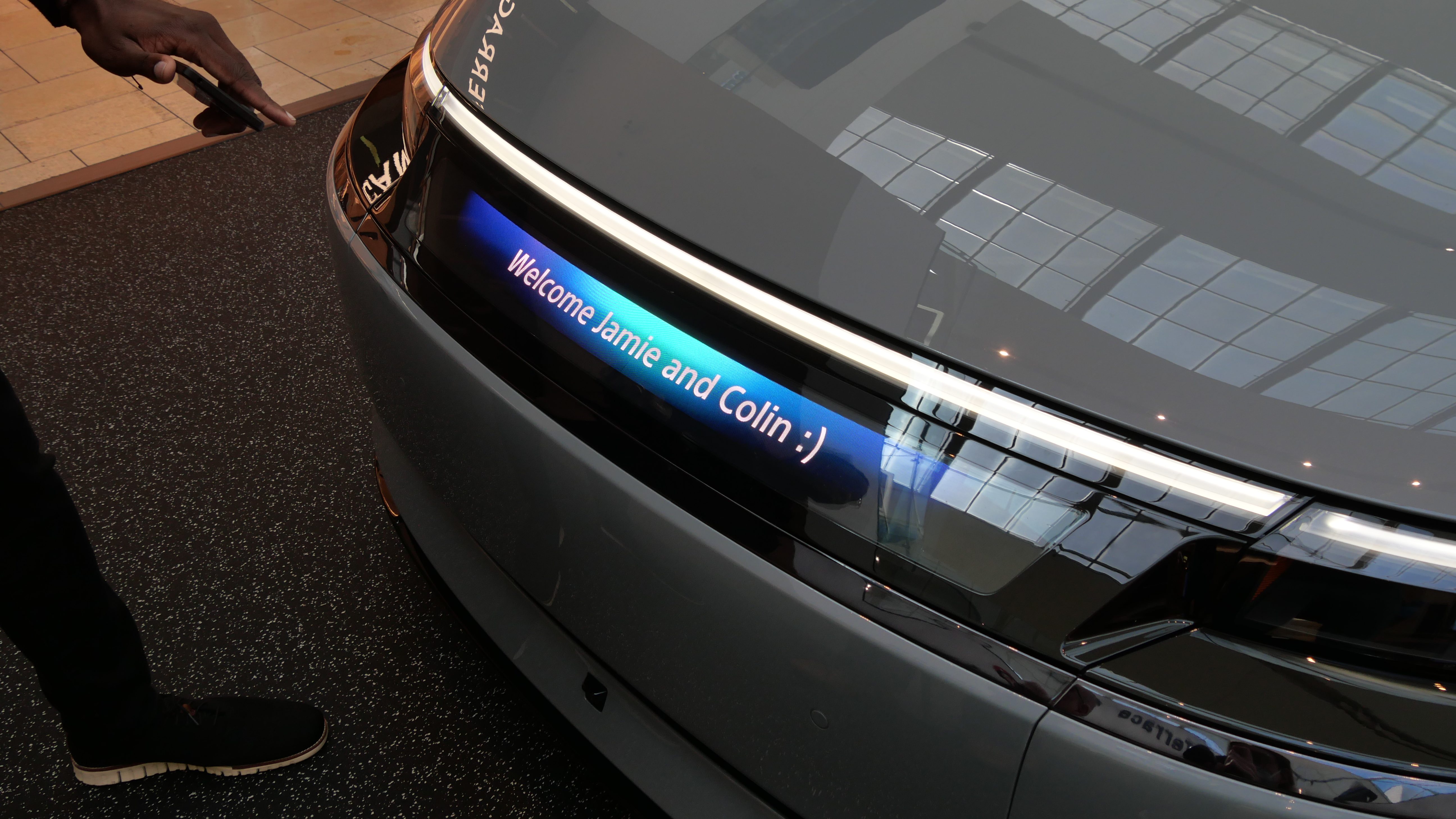
This feature is currently controlled by a phone app for demo purposes, and responded quickly as our guide swiped through various display possibilities. These included various themes, a battery display to check your charge level, or messages that could be relevant while driving (e.g. flashing “WARNING” when hazard lights are active).
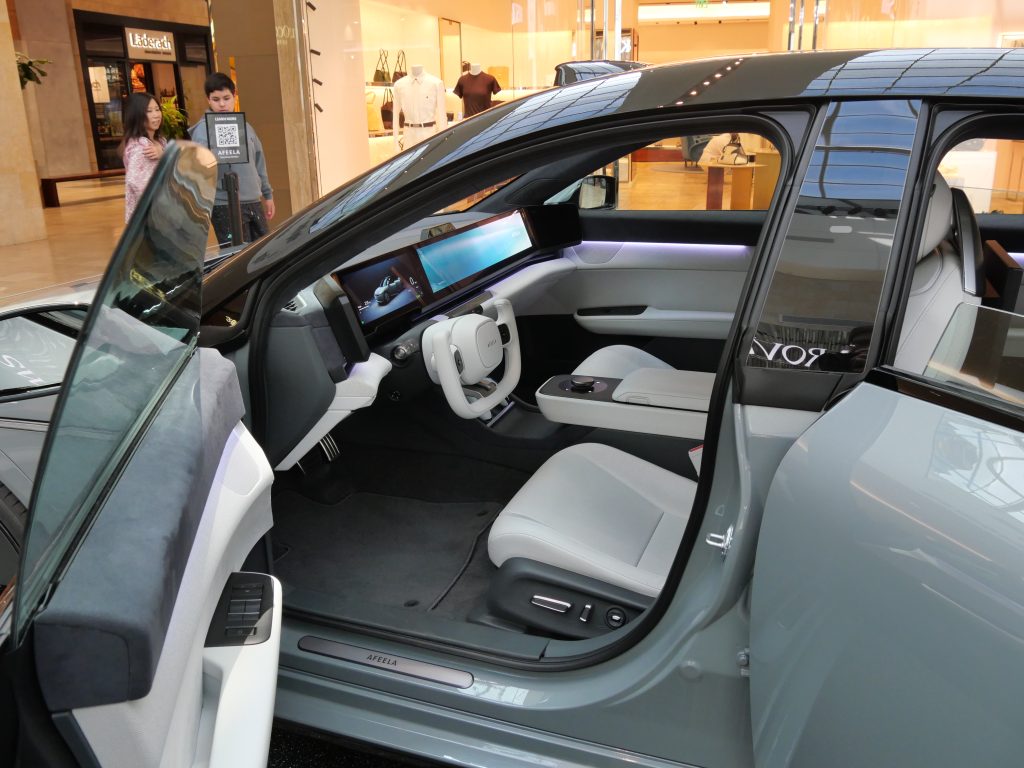
Heading into the car, the doors are intended to have facial recognition (or perhaps were opened by our tour guide furtively pressing a button on his phone app) and are auto-opening and closing, though there is also a small button at the edge of the door that we could use to open it.
From the driver’s seat, the cockpit view is pretty satisfying. Visibility felt good and the cabin is quite spacious. The yoke steering wheel – which may or may not be standard or an option, SHM hasn’t decided yet – does offer a nice clear view of the instrument cluster. And it may use steer by wire, though that again has not yet been decided.
The giant wraparound screen offers important instruments in front of the driver (along with a HUD, which wasn’t activated for the demo), and a wide screen for nav or entertainment in the center and in front of the passenger.

Various apps can be brought up on the screen, and swiped between middle-screen and passenger-side (whether or how they’ll be active while the car is in motion is still being investigated), and themes are customizable and can affect the car’s ambient lighting, exterior media bar, and even motor sounds (and in my opinion, they better let us turn them off).
The side portions of the screen are for digital side mirrors, though the car is also expected to come with physical side mirrors as US regulators do not allow all-digital mirrors yet. The rear-view mirror is a hybrid optical/digital mirror, but wasn’t active in the prototype.
Many of the apps were not active in the tech demo, but we got a general sense of the snappiness and design of this (albeit restricted) version of the UI. And, like we’ve seen from many of the “EV startup” companies, it worked a lot better than what you generally expect out of traditional automaker UIs. Chalk one up to Sony’s software expertise here, they are clearly taking the lead on the in-car experience parts of this joint venture (and plan to offer over-the-air updates, something that is very popular among Tesla/Rivian owners, that traditional automakers are slowly getting around to implementing).
We got a short chance to demo playing Horizon Zero Dawn: Forbidden West in the car, but given how wide and short the screen is, the window was quite small. Maybe it would look better on the back seat screens.
And, it doesn’t actually run on the in-car system – we were using the PlayStation 5’s “remote play” feature, which lets you stream gameplay over the internet from a PS5 connected somewhere off-site. This adds latency depending on your distance from servers and your connection type (i.e., mobile data, from a car), so it’s not great for games with quick action or reaction times, but could work for e.g. story and puzzle games (there also seemed to be some additional latency/bluetooth interference when holding the controller in a lower position, but again, prototype).
That said, one weird thing about the in-car experience is that it was really hot in there. As soon as we closed the doors, it felt like the heater was on, and the touchscreen was also quite warm to the touch. It’s clear that Sony has packed some serious computing power in the vehicle, and that computer seems to have been really pumping out the processor cycles to ensure the best UI demo. Heat management is still on the to-do list.

Moving to the back seat, each seat has a large screen for the rear passengers, which will eventually offer various features, but as-is only showed us a static image of a map (very useful for backseat drivers) and a button to bring up an app-switcher with several inactive apps. You’ll eventually be able to use it for games, music, movies, climate control functions and so on.
Back seat space was quite good, with exceptional legroom and just-about adequate headroom. With the front seat set to a comfortable position for a 6′ driver, I still had a good ~5 inches of knee room, suggesting that legroom won’t be a problem in the vehicle. Headroom isn’t quite as expansive, but was still fine for someone like myself who is prone to slouching. And our tour guide was about ~6’3″ and seemed to fit alright, as you can see in this video.
We didn’t get to see in the trunk, or under the hood (frunk?), or in the charge ports – which are on both sides of the vehicle, but we don’t know if they’ll use NACS or not (but they had better, considering literally everyone else will soon).
The AFEELA will have a full suite of sensing abilities for safety and driver assistance, with the goal of achieving “level 2+ or level 3” autonomy, according to the reps we talked to (though previously SHM has said level 3/4). The difference between levels 2 and 3 is quite significant, though – the only level 3 system on (some) US roads currently is Mercedes DRIVE PILOT, and the big jump here is that level 3 systems can take responsibility for the driving task in certain situations, whereas level 2 cars are always the responsibility of a human driver.
So not only is there a big step between those two, but there’s a lot of variation within level 2 systems. SHM says that it will utilize machine learning to develop its autonomous software – which is a bit of a nod to that AI buzzword it dropped a lot at CES this year, but which is indeed an effective way to develop autonomous software.
That said, currently, even with the newest “mind-blowing” version of FSD, Teslas are still level 2 vehicles that require human drivers. And Tesla has a lot more driving data to comb through with its machine learning algorithms (which it only recently started doing with FSD v12) than SHM (or anyone) has. So we think it’s ambitious to suggest the AFEELA will be level 3 capable anywhere near its 2026 release target.
But – SHM does have more sensors than Tesla does. Tesla has waffled between using vision-only, vision-plus-radar, and vision/radar/ultrasonics systems, but AFEELA uses all of those plus LiDAR – complete with a LiDAR “taxi bump” above the windshield.

And SHM does have Honda behind it, which means that all of these in-car experiences that Sony showed off will be paired with Honda’s global-scale manufacturing and distribution network. The plan is to build the car in Ohio (which means potential US tax credit availability, though SHM hasn’t announced a battery supplier yet – though Honda is co-invested in an Ohio facility with LG), though Sony would like to establish direct customer relationships rather than going through dealers. That decision is still somewhat up in the air, though – either option has its positives and negatives.
Now – as I’ve mentioned many times, and as SHM told me many times, this was more of a tech demo than anything. We asked SHM a lot of questions about what will happen with this car, and they couldn’t really answer many of them (including no comment on the SUV variant). There are a lot of decisions still to be made – or at least, that have not yet been publicized – in the next 2 years before this car hits the road. As you’ve probably noticed throughout the above text.
The sheer scale of the decisions that still need to be made does make us question whether 2026 is still in the cards. Sony has been working on this car for a long time now – since before 2020 – so 2026 isn’t an unreasonable timeline in that respect. And I’ve long been impressed by the gradual nature of Sony’s, and now SHM’s, reveals about this vehicle. They’re not promising the world or anything too unrealistic (well, until this last CES – it got too buzzwordy, with AI and AR and what-have-you), now they just have to execute on what have mostly been realistic goals.
But there’s still a whole lot to do, or at least a whole lot to announce, before we get there. And they’ve said they plan to take preorders in the US starting first half of 2025, so that’s only a year away.
It feels like a daunting task – but unlike other “EV startups,” this one is funded by two of the largest companies in Japan who have tons of experience both in software/UX and auto manufacturing (though perhaps not much in EV manufacturing, yet). So it’s a little different than evaluating a prototype of a starting-from-scratch EV startup. They’ve certainly got the resources to bring this over the line, and we’re excited to see what it looks like when they do.
FTC: We use income earning auto affiliate links. More.





Comments